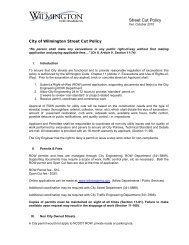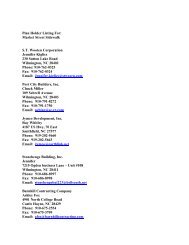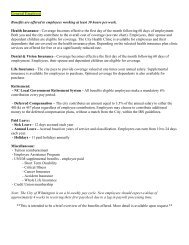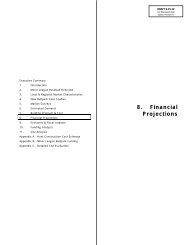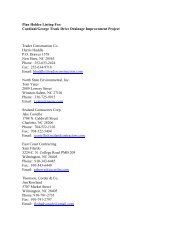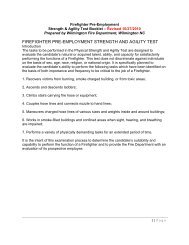article 5. zoning district regulations - City of Wilmington
article 5. zoning district regulations - City of Wilmington
article 5. zoning district regulations - City of Wilmington
You also want an ePaper? Increase the reach of your titles
YUMPU automatically turns print PDFs into web optimized ePapers that Google loves.
Land Development Code<br />
<strong>City</strong> <strong>of</strong> <strong>Wilmington</strong><br />
GROUP 2:<br />
(1) Conservation space setbacks. All structures and impervious surfaces shall be<br />
setback from the conservation space, if any, whether the space is located on the parcel<br />
or on an adjacent parcel, a distance <strong>of</strong> at least seventy-five (75) feet.<br />
(2) Retention <strong>of</strong> run<strong>of</strong>f. In addition to designing the site to control stormwater from<br />
a ten-year storm, on-site retention or percolation areas shall be required for the entire<br />
parcel sufficient to control, at a minimum, the first 0.75 inch <strong>of</strong> run<strong>of</strong>f that will<br />
originate from all impervious surfaces anticipated to be on the site upon final<br />
development. The specified amount <strong>of</strong> run<strong>of</strong>f from impervious surfaces shall be<br />
disposed <strong>of</strong> by percolation into the soil, evaporation, transpiration, or other methods<br />
<strong>of</strong> treatment or handling acceptable to the development management division.<br />
GROUP 3:<br />
(1) Conservation space setbacks. All structures and impervious surfaces shall be<br />
setback from the conservation space, if any, whether the space is located on the parcel<br />
or on an adjacent parcel, a distance <strong>of</strong> at least fifty (50) feet.<br />
(2) Retention <strong>of</strong> run<strong>of</strong>f. In addition to designing the site to control stormwater from<br />
a ten-year storm, on-site retention or percolation areas shall be required for the entire<br />
parcel sufficient to control, at a minimum, the first 0.5 inch <strong>of</strong> run<strong>of</strong>f that will<br />
originate from all impervious surfaces anticipated to be on the site upon final<br />
development. The specified amount <strong>of</strong> run<strong>of</strong>f from impervious surfaces shall be<br />
disposed <strong>of</strong> by percolation into the soil, evaporation, transpiration, or other methods<br />
<strong>of</strong> treatment or handling acceptable to the <strong>City</strong> engineering department.<br />
GROUP 4:<br />
(1) Conservation space setbacks. All structures and impervious surfaces shall be<br />
setback from the conservation space, if any, whether the space is located on the parcel<br />
or on an adjacent parcel, a distance <strong>of</strong> at least twenty-five (25) feet.<br />
(2) Retention <strong>of</strong> run<strong>of</strong>f. In addition to designing the site to control stormwater from<br />
a ten-year storm, on-site retention or percolation areas shall be required for the entire<br />
parcel sufficient to control, at a minimum, the first .25 inch <strong>of</strong> run<strong>of</strong>f that will<br />
originate from all impervious surfaces anticipated to be on the site upon final<br />
development. The specified amount <strong>of</strong> run<strong>of</strong>f from impervious surfaces shall be<br />
disposed <strong>of</strong> by percolation into the soil, evaporation, transpiration, or other methods<br />
<strong>of</strong> treatment or handling acceptable to the <strong>City</strong> engineering department.<br />
(f) Vegetated buffer controls for conservation lands.<br />
(1) Purpose and intent. The establishment <strong>of</strong> a buffer zone is based upon the stated<br />
goals in Policies 3.10 and 3.11 <strong>of</strong> the 1998 <strong>Wilmington</strong>-New Hanover County<br />
Comprehensive Plan. The buffer zone is intended to promote the comprehensive plan<br />
goals <strong>of</strong> high water quality in the creeks and sounds, to protect the public health, and<br />
to ensure the protection <strong>of</strong> the natural resources <strong>of</strong> New Hanover County.<br />
A properly vegetated buffer is essential to filter and biologically process nutrient rich<br />
run<strong>of</strong>f, animal wastes, and sediment before it enters coastal creeks, canals, and rivers.<br />
Buffers also function to moderate water temperatures, maintain the desired dissolved<br />
oxygen levels in the water, and stabilize the soils immediately adjoining the stream.<br />
In urban environments, the function <strong>of</strong> a buffer is especially critical to the balance <strong>of</strong><br />
ARTICLE <strong>5.</strong> ZONING DISTRICT REGULATIONS Page 140




